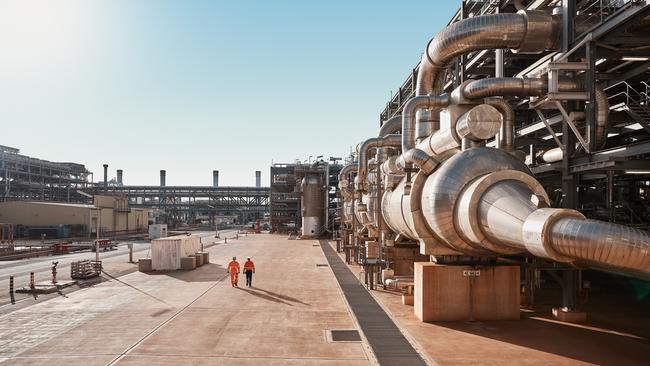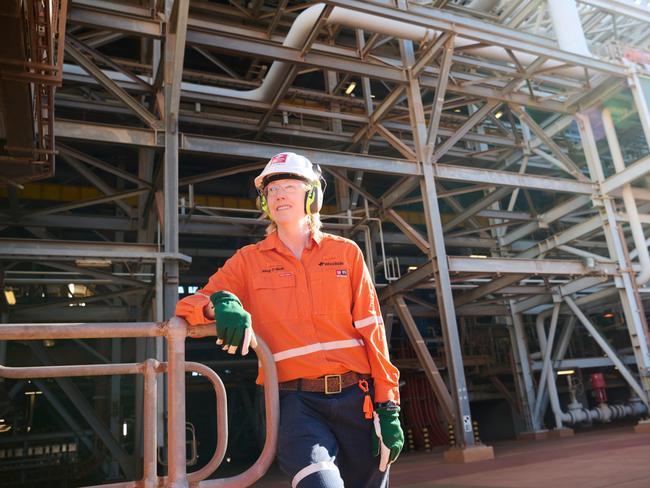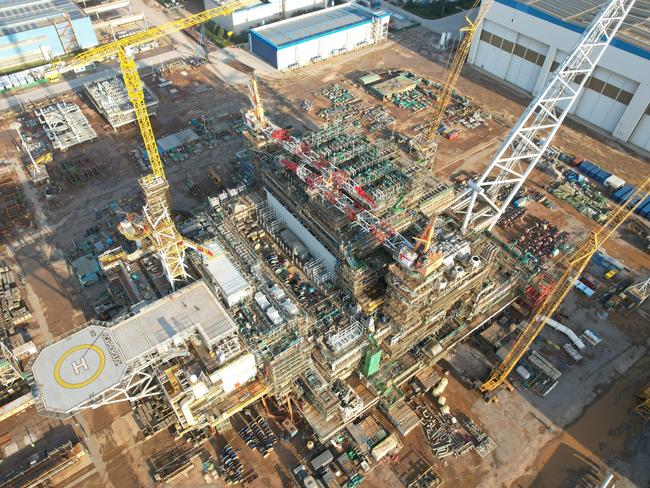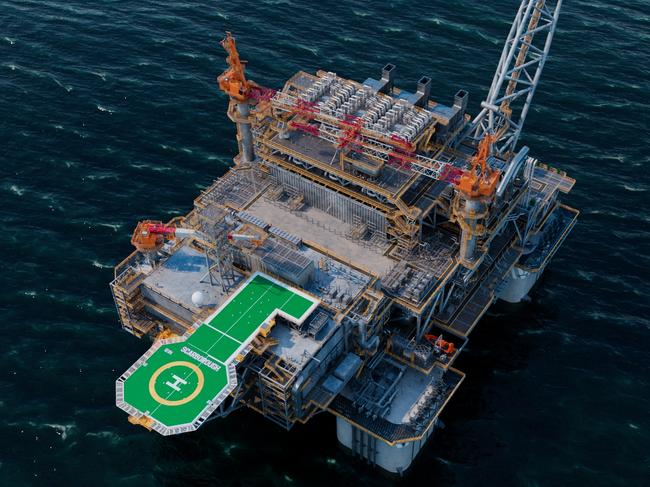Woodside Energy’s controversial $18.7bn Scarborough LNG project nears completion
Woodside is under pressure to show it can guarantee shareholder returns while investing in growth, with its $18bn Scarborough LNG project set to come online in 2026.

Business
Don't miss out on the headlines from Business. Followed categories will be added to My News.
On the day Donald Trump was elected for a second term on a platform of dramatically boosting US fossil fuel production, Woodside’s chief executive Meg O’Neill was toasting her own milestone – Australia’s largest gas development in a decade is rapidly approaching the finishing line and the first shipment of gas is expected to be shipped in 2026.
The $US12.5bn ($18.7bn) Scarborough development has been earmarked as the next major driver of Woodside’s growth, but the stakes are high. The project has become a lightning rod for green opposition, and Woodside’s share price is languishing near a three-year low, underwhelming some investors who fear the company’s capital expenditure is undermining shareholder value.
The Scarborough natural gas field in the Carnarvon Basin, about 375km off the coast of Western Australia, is contentious to say the least.

Environmental groups have labelled it a “carbon bomb” and launched a spate of legal challenges and public relations campaigns that threaten to slow work and first shipments.
Woodside cannot afford to frustrate shareholders with delays, which would inevitably lead to revenue declines. But any lingering concerns were overcome during a two-day investor tour of its operations in Karratha, with Ms O’Neill declaring that the facility is making rapid progress.
“Over the last two days you have seen the great progress we are making on the Scarborough energy project. We remain on target for our first LNG cargo in 2026,” Ms O’Neill told investors.
Woodside earlier this year secured the last of its regulatory approvals for the project after a green group agreed to dismiss its court challenge. The Australian Conservation Foundation had in June, 2022 asked the country’s Federal Court to stop Woodside from working on the Scarborough gas project until an assessment of its potential impact on the Great Barrier Reef was made.

Woodside, however, continued to push on and Ms O’Neill said the project was now 73 per cent complete.
The rapid development of the project is reflected by the speed at which one of Australia’s largest cranes is moving, on site at Karratha. Its job is to help construct the second train at Woodside’s Pluto LNG development.
Woodside senior vice president Michael Robinson, who oversees the Scarborough project, said the key to deployment was the modular design of the train – which processes, purifies and converts natural gas into LNG.
The train will be delivered in modules from Indonesia, where it is being constructed, before being pieced together like a Meccano set.
Woodside has now received 45 of the 51 modules to be delivered. Ms O’Neill said 41 modules were already in place.

The gas will be extracted from an initial eight wells, one of which is already completed. Eventually some 13 wells will be dug, which will be tied back to a semi-submersible floating production unit that will then connect to a 430km pipeline which will carry the gas to the second LNG train.
About five million tonnes of gas will be processed through the second train each year.
The latest Scarborough forecasts will temper some market anxiety. Woodside’s standing was tested when it when it announced the acquisition of Driftwood from US LNG company Tellurian in a deal worth $US1.2bn. The buyout made it one of the world’s biggest LNG players. Woodside has subsequently renamed Driftwood as Louisiana LNG.
Weeks later Woodside announced it agreed to purchase a low-carbon ammonia production facility in Texas from US company OCI Global in a deal worth $US2.35bn.
Woodside has pledged to make a final investment decision on Louisiana LNG soon, but with estimates for the development of up to $US10.6bn some investors have questioned whether the company will have to cut its dividend policy.
Woodside chief financial officer Graham Tiver said the company was extremely confident that it could achieve both goals.
“We look at cashflows coming in. We have Sangomar coming in 2024 (financial year), we have Scarborough in 2026 and Trion in 2028,” Mr Tiver said.
“We have the capacity to balance strong, fully franked returns to our shareholders, which provides that near-term return, while also investing in value,” he said.
Market sentiment could improve if Woodside secures a deal to sell down its exposure in Louisiana LNG.
Ms O’Neill declined to comment on reports Woodside is in talks with Tokyo Gas over an equity stake sale for Louisiana LNG, but revealed the company had received approaches. “We had a number of companies that had approached us and said, ‘If Woodside wants to do anything in North American LNG, we’d love to partner with you’,” Ms O’Neill said.
Woodside has said it wants to sell as much as 50 per cent of Louisiana LNG.
The reporter travelled to Western Australia as a guest of Woodside.
More Coverage
Originally published as Woodside Energy’s controversial $18.7bn Scarborough LNG project nears completion





